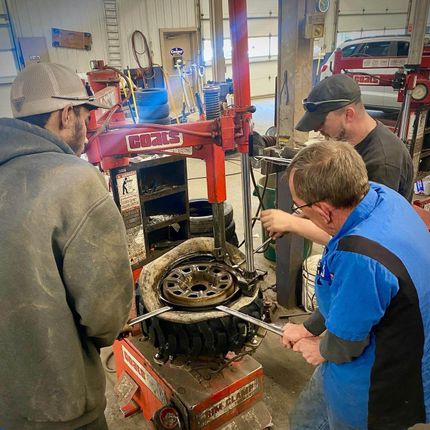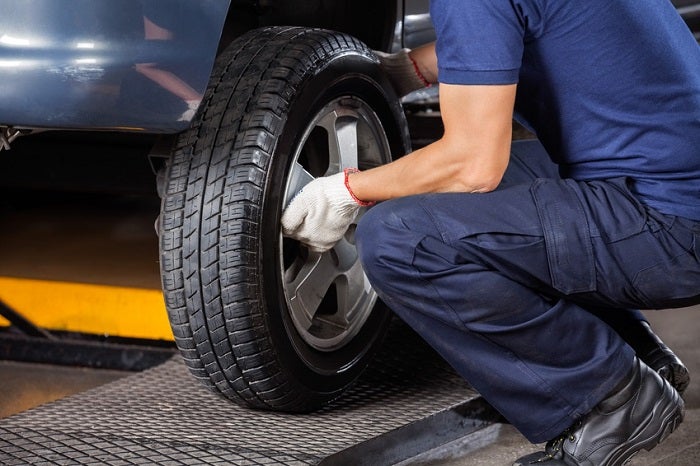Elevate Your Ride: Count On Morris Tires for GMC Tires Service
Wiki Article
Tire Service: The Influence of Climate Condition
When it comes to making certain optimal performance and safety on the roadway, recognizing the influence of climate conditions on tire service is critical. GMC Tire Service. In this conversation, we will certainly check out the intricate relationship in between weather problems and tire solution, dropping light on the value of weather-specific tire maintenance techniques and considerations.Warm and Tire Efficiency
When revealed to high temperature levels, tires experience modifications in performance that can substantially affect car safety and security and handling. The warmth produced from extended driving or hot weather condition conditions creates the tire rubber to soften, causing decreased tread life and raised wear. As the rubber becomes softer, the tire's grasp when traveling reduces, affecting braking distances and overall grip. In extreme situations, too much heat can even trigger tire blowouts, positioning an extreme safety and security threat to the car and its residents.
Cold Climate Effects
Winter conditions can have a significant effect on tire performance and security. As temperatures decrease, tire rubber can solidify, causing reduced traction on icy or snow-covered roads. In cool climate, tires may also shed air pressure extra quickly, which can influence dealing with and gas effectiveness. Additionally, chilly temperatures can cause tire sidewalls to tense, increasing the risk of damage from splits or other road risks.To alleviate the impacts of cool climate on tires, it is important to frequently inspect tire pressure and inflate them to the supplier's advised degrees. Using winter months or all-season tires designed for winter conditions can additionally boost traction and grasp on icy or snowy roads. Proper tire maintenance, including regular evaluations for wear and damage, ends up being much more essential throughout chillier months to make certain optimal performance and safety and security.
Rainy Conditions Impact
Throughout wet conditions, tire performance and safety and security can be significantly influenced by the damp road surfaces and decreased visibility. The tread pattern of tires plays a crucial duty in keeping grip on wet roads. Tires with worn-out treads are extra vulnerable to hydroplaning, where a layer of water accumulates between the tire and the road surface, bring about loss of grip. To fight this, vehicle drivers ought to frequently inspect their tires for adequate walk depth and take into consideration purchasing tires especially created for wet problems.In addition, wet climate can likewise decrease visibility, making it testing for motorists to see the road in advance clearly (GMC Tire Service). In such problems, it is important to readjust driving speeds accordingly and preserve a risk-free adhering to range to permit abrupt stops. Appropriately filled with air tires can likewise help in keeping control on damp roads by providing better handling and grip
Snow and Tire Security
Snow-covered roadways position special obstacles for chauffeurs, highlighting the significance of proper tire choice and upkeep. When driving in snowy conditions, having the appropriate tires can make a considerable distinction in security and performance. Wintertime tires are created with unique rubber substances and walk patterns to supply much better traction on snow and ice compared to all-season tires. The much deeper treads and sipes of winter tires aid grip the roadway better, lowering the risk of sliding and sliding.
It is important to adhere to maker guidelines when using and setting up tire chains to protect against damages to the tires and automobile. By selecting the best tires, preserving correct inflation, and thinking about additional grip aids like tire chains, Bonuses chauffeurs can improve their safety when browsing snow-covered roads.
Weather-Related Tire Upkeep
When confronted with various climate condition, correct tire upkeep comes to be a vital element of car safety and security and performance. Weather-related tire upkeep encompasses a variety of techniques aimed at useful source making sure optimal tire function and durability in different weather condition situations. One essential element of weather-related tire upkeep is tire pressure law. Varying temperatures can create tire pressure to differ, impacting traction and fuel efficiency. Consistently readjusting and inspecting tire pressure according to maker suggestions is important for secure driving in transforming climate condition. Additionally, tire tread deepness plays a substantial duty in managing various weather condition aspects. Tires with appropriate tread depth give far better grip on damp or icy roads, reducing the threat of skidding or hydroplaning. When tread wear reaches a specific deepness is important for preserving traction and security in negative climate, checking tire tread frequently and changing tires. By focusing on weather-related tire upkeep, motorists can improve safety, improve lorry performance, and extend the life-span of their tires.
Conclusion
In conclusion, weather problems have a substantial effect on tire performance and safety. From warmth impacting tire stress and use to cool weather condition decreasing grip, it is necessary to take into consideration the climate when keeping and making use of tires.In this discussion, we will discover the intricate relationship in between weather condition problems and tire solution, losing light on the relevance of weather-specific tire maintenance techniques and factors to consider.

Report this wiki page